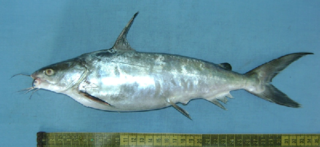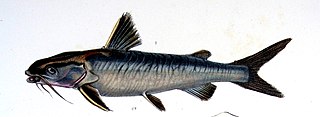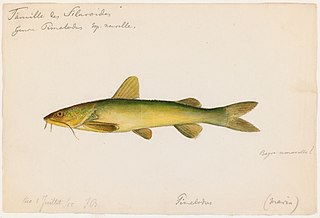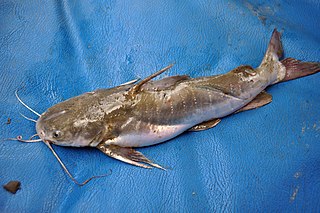
The giant catfish, also known as the giant sea catfish, giant salmon catfish, giant marine-catfish, or the khagga, is a species of catfish in the family Ariidae. It was described by Eduard Rüppell in 1837, originally under the genus Bagrus. It inhabits estuaries and occasionally freshwater bodies, in Japan, Australia, Polynesia, southern Vietnam in the Mekong Delta, the Red Sea and the northwestern Indian Ocean. It dwells at a depth range of 10 to 195 m. It reaches a maximum total length of 185 cm (73 in), but usually reaches a TL of 70 cm (28 in).
The bronze catfish, also known as the giant catfish, the roundsnout sea catfish, or the two-line sea catfish, is a species of catfish in the family Ariidae. It was described by Achille Valenciennes in 1840, originally under the genus Bagrus. It inhabits marine, brackish and freshwaters throughout the Indo-western Pacific. It reaches a maximum standard length of 62 cm (24 in).

Neoarius berneyi, the highfin catfish, Berney's catfish, Berney's shark catfish, or the lesser salmon catfish, is a freshwater sea catfish that is commonly kept in aquariums. The origin of the name Neoarius berneyi is Greek, with the genus name Neoarius coming from the words neos meaning new and arios, meaning warlike or hostile, in reference to the well developed fin spines, and the species name, berneyi, comes from the ornithologist F. L. Berney.

Genidens barbus, the white sea catfish or marine catfish, is a species of catfish in the family Ariidae. It was described by Bernard Germain de Lacépède in 1803, originally under the genus Pimelodus. It is an oceanodromous species that is found between the mouth of Negro River in Patagonia and eastern Brazil. It reaches a maximum total length of 120 cm (47 in). It has been recorded spawning between the months of August–December. The maximum known life expectancy is 36 years.
The Bressou sea catfish, also called the marine catfish, is a species of sea catfish in the family Ariidae. It was described by Achille Valenciennes in 1840, originally under the genus Arius. It inhabits tropical marine, brackish and freshwater on the Atlantic coast of South America, ranging from Guyana to Brazil. It reaches a maximum total length of 50 cm (20 in), but more commonly reaches a TL of 30 cm (12 in).

Cathorops spixii, the Madamango sea catfish, raspfin sea catfish or spring cuirass, is a species of catfish in the family Ariidae. It was described by Louis Agassiz in 1829. It is a tropical, marine and brackish water-dwelling catfish which occurs between Colombia and Brazil. It inhabits a depth range between 1 and 50 m. It reaches a maximum total length of 30 cm (12 in), more commonly reaching a TL of 20 cm (7.9 in).

Neoarius graeffei, or blue salmon catfish, is a species of catfish found in freshwater rivers of Australia and Papua New Guinea. This species is most identifiable by its large, shark-like dorsal fin that is led by a poisonous spine. Like other catfish, the blue salmon catfish is known to use electrical pulses to sense prey in the water. This prey sensing mechanism may be the reason that these catfish are known to eat the land dwelling hopping mouse at a high rate.

Hexanematichthys sagor, the Sagor catfish, Sagor sea catfish, Sunda sea-catfish, marine catfish or dusky catfish, is a species of catfish in the family Ariidae. It was described by Francis Buchanan-Hamilton in 1822, originally under the genus Pimelodus. It inhabits estuaries and freshwater bodies in numerous areas of the Indo-Western Pacific Ocean. It reaches a maximum total length of 45 cm (18 in), more commonly reaching a TL of 30 cm (12 in).
Neoarius coatesi, or Coates' catfish, is a species of catfish in the family Ariidae. It was described by Patricia J. Kailola in 1990, originally under the genus Arius. It is endemic to Papua New Guinea, being only known from the Sepik and Ramu Rivers. It reaches a maximum standard length of 75 cm (30 in), more commonly reaching an SL of 45 cm (18 in). Its maximum known weight is 5 kg (11 lb).
Neoarius latirostris, the broad-snouted catfish, is a species of catfish in the family Ariidae. It was described by William John Macleay in 1883, originally under the genus Arius. It inhabits freshwater rivers in Indonesia and Papua New Guinea. Its diet includes finfish, mollusks, prawns, terrestrial arthropods, aquatic insects, and plants. It reaches a maximum standard length of 50 cm (20 in).
Neoarius midgleyi, the silver cobbler, Lake Argyle catfish, Lake Argyle silver cobbler, Midgley's catfish, Ord River catfish, shovel-nosed catfish, or shovelhead catfish, is a species of catfish in the family Ariidae. It was described by Patricia J. Kailola and Bryan E. Pierce in 1988, originally under the genus Arius. It inhabits brackish and freshwaters in northern Australia. It is known to reach a maximum standard length of 140 cm (55 in), but usually reaches an SL of 50 cm (20 in).
Neoarius pectoralis, the sawspine catfish or sawspined catfish, is a species of catfish in the family Ariidae. It was described by Patricia J. Kailola in 2000, originally under the genus Arius. It inhabits marine and brackish waters in Australia, Irian Jaya, and possibly also Papua New Guinea. It reaches a maximum fork length of 39.3 cm (15.5 in).
Neoarius utarus, the northern rivers catfish or salmon catfish, is a species of catfish in the family Ariidae. It was described by Patricia J. Kailola in 1990, originally under the genus Arius. It inhabits freshwater bodies in Indonesia and Papua New Guinea.
Neoarius velutinus, the papillate catfish, is a species of catfish in the family Ariidae. It was described by Max Carl Wilhelm Weber in 1907, originally under the genus Hemipimelodus. It inhabits freshwater lakes and rivers in New Guinea. Its diet includes mayflies and other terrestrial and aquatic insects, detritus, benthic algae, and crustaceans.
The Arafura catfish, also known as the Arafura sea catfish, is a species of catfish in the family Ariidae. It was described by James Douglas Ogilby in 1898, originally under the genus Arius. It inhabits marine, brackish and freshwaters in the western Pacific. It reaches a maximum standard length of 46 cm (18 in).
The Mozambique sea catfish, also known as the Mozambican sea catfish, is a species of catfish in the family Ariidae. It was described by Pieter Bleeker in 1846, originally under the genus Arius. It inhabits marine and freshwaters in the western Pacific and western Indian Ocean. It reaches a maximum standard length of 35 cm (14 in).

The Pemecou sea catfish, also known as the flapnose sea catfish, the mud cuirass, or the gillbacker, is a species of catfish in the family Ariidae. It was described by Marcus Elieser Bloch in 1794, originally under the genus Silurus. It inhabits marine, brackish and freshwaters in Brazil, Guyana, French Guiana, Colombia, Suriname, Venezuela, and Trinidad and Tobago. It dwells at a depth range of 1 to 5 m. It reaches a maximum total length of 94.2 cm (37.1 in), while males more commonly reach a TL of 30 cm (12 in) and females reach a TL of 62.5 cm (24.6 in). It reaches a maximum weight of 1.5 kg (3.3 lb).
Sciades paucus is a species of catfish in the family Ariidae. It was described by Patricia J. Kailola in 2000, originally under the genus Arius. It inhabits freshwaters in Australia. It reaches a maximum total length of 130 cm (51 in), and a maximum weight of 2.8 kg (6.2 lb).
The crucifix sea catfish — also known as the Christfish, the crucifix/crucifex catfish, the crucifixfish, or the gillbacker, — is a species of catfish in the family Ariidae.






